Collection
From Art Nouveau to ZERO, from Claude Monet to Gerhard Richter – the collection of the Kunstmuseen Krefeld now encompasses circa 24,000 works from the Late Middle Ages to the present day and continues to grow.
on View
The Kunstmuseen Krefeld work continuously with their rich and diverse collection. Presentation and research often go hand in hand. Many thematic as well as monographic exhibitions have specific references to the collection and are enriched from the museum's own holdings. In Collection in Motion on the 1st floor of the Kaiser Wilhelm Museum, part of the collection is on permanent display. Here, 15 themes can be experienced in 15 rooms. Individual rooms are regularly restaged so that the diversity of the collection becomes visible. In the Collection Satellites series, creative minds from various disciplines engage with the museum's collection or history and develope new works.
In addition to the exhibitions and the permanent presentation, there are permanent works and installations by Joseph Beuys, Elmgreen & Dragset, Yves Klein, Johan Thorn Prikker and others in both the Kaiser Wilhelm Museum and Haus Lange Haus Esters. In the garden of Haus Lange Haus Esters there are further sculptural works by Michael Craig-Martin, Ludger Gerdes, Berto Ladera, Richard Long, Claes Oldenburg, David Rabinowitch, Ulrich Rückriem, Thomas Schütte, Richard Serra and Andrea Zittel.
One of the highlights of the year is an exhibition of everyday objects designed by Wilhelm Wagenfeld (1900–1990). Whether it's the famous table lamp he designed while still at the Bauhaus in Weimar or the heat-resistant glass household products he developed with Jenaer Glaswerke: with his designs characterized by functionality and timeless design, Wagenfeld is one of the most important product designers of the 20th century. In connection with a purchase that significantly strengthens the design collection of the Kunstmuseen Krefeld, a room in the Collection in Motion is dedicated to him on the occasion of his 125th birthday.
As of now another room presents a cooperation with the Adolf Luther Foundation. The new presentation Color and transparency focuses on Luther's characteristic concave mirror objects—compositions of square, concave, and convex mirrors in silver and blue that make the light in the room tangible. They are complemented by an early “dematerialization” from 1961: an impasto blue color sculpture in a rotating metal frame that clearly references the monochrome works of Yves Klein. Luther used glass and mirrors to develop the unmistakable signatures of his artistic work. In 1985, together with jewelry designer Susanne Dünne, he also designed a collection consisting of a ring, necklace, brooch, and watch. The elements of his concave mirror objects are incorporated into these pieces of jewelry.
Convolutes of the collection of objects of non-European origin is being presented for the first time. These are primarily arts and crafts from Africa, Oceania and South East and East Asia, which came to the Kaiser Wilhelm Museum between 1891 and 1930 and were intended to serve as inspiration for local artistic and industrial production. The provenance and cultural contexts of the objects were investigated in an extensive project funded by the Deutsches Zentrum Kulturgutverluste. The presentation introduces the objects and tells the story of their provenance.
The Kunstmuseen Krefeld are expanding their collection with a donation from the Düsseldorf jewelry designer and visual artist Linda Müller. Her works enter into an extraordinary dialog with historical Art Nouveau objects from the museum's founding period around 1900. The KWM's historical collection includes works by the Danish silversmith Georg Jensen, who opened his own workshop in Copenhagen in 1904 and quickly became one of the leading Art Nouveau jewelry designers. His floral and ornamental designs bear witness to the precision of his craftsmanship, his artistic flair and the close connection between art and nature. This chapter is supplemented by so-called katagami - Japanese coloring stencils from the 19th century. Their filigree workmanship and aesthetic effect inspired numerous European artists and had a lasting influence on the formal language of Art Nouveau.
Under the title A Perceived World, a room at the KWM is dedicated to this progressive style of painting, which is primarily concerned with the expression of the inner emotional world. While the painters of the Brücke formed in Dresden and the Blaue Reiter in Munich, a Rhenish variant emerged in 1913 on the occasion of an exhibition in Bonn. Among the participating artists were the painters Heinrich Campendonk, Helmuth Macke and Heinrich Nauen, who are now on display in a room at the KWM. All three come from Krefeld, are closely associated with the history of the KWM and are among the most important representatives of Rhenish Expressionism. The new room in Collection in Motion tells their story and shows how painting detached itself from the canvas and was transferred to furniture, textiles, glass windows and walls.
Another new room on the first floor of the KWM is dedicated to the creative ideas and innovative formal language of modernism in the 1920s. Paintings and prints by pioneering figures such as Piet Mondrian (1872 - 1944), Anni Albers (1899 - 1994) and László Moholy-Nagy (1895 - 1946) are arranged with tubular steel furniture by Ludwig Mies van der Rohe (1886 - 1969) and Marcel Breuer (1902 - 1981), which recently entered the collection of the Kunstmuseen Krefeld as new acquisitions. The formal interplay of everyday objects and paintings shows how fluid the boundaries between image, spatial and object design were at the time. The artists and designers were concerned with a systematic organization of means, a generally understandable expression and a reduction to elementary design elements. Teaching at the State Bauhaus, where Marcel Breuer and Anni Albers, among others, studied and which Ludwig Mies van der Rohe later directed, was also based on these ideas.
In 2020, the Kunstmuseen Krefeld launched a new concept for the presentation of its collection that introduces the extensive holdings in a dynamic, varied way and with diverse themes. Under the title Collection in Motion, 15 stories line up like a string of pearls in the 15 rooms on the second floor of the Kaiser Wilhelm Museum. Again and again, a new room emerges, and sculptures, paintings, photography and design objects come together to form other surprising stories. Other rooms are thematically dedicated to, among others, Herbert Zangs, Street Photography and Pop Art.
On the 1st floor of the Kaiser Wilhelm Museum, Collection in Motion is currently showing works by: Anni Albers, Heinrich Campendonk, Alan Charlton, Eric Chevallier, Katharina Fritsch, Günter Fruhtrunk, Dan Graham, Erich Heckel, Anton Henning, Yves Klein, Adolf Luther, Helmuth Macke, Ludwig Mies van der Rohe, Laszlo Moholy-Nagy, Piet Mondrian, Linda Müller, Heinrich Nauen, Gerhard Richter, Dieter Roth, Wilhelm Wagenfeld, Andy Warhol and others.
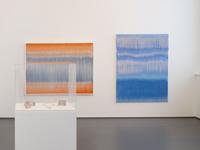
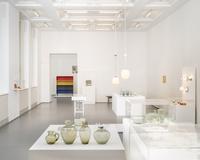
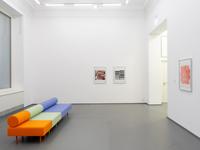
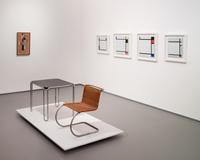

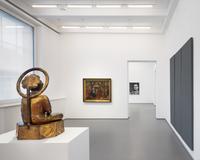

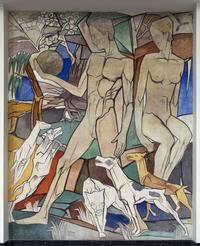
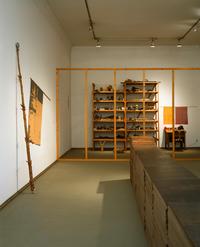
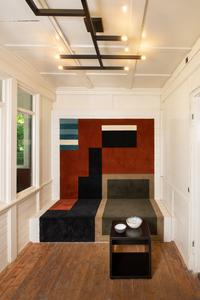
HLHE Sculpture Garden, Collection Kunstmuseen Krefeld and permanent loan of Freunde der Kunstmuseen Krefeld e.V.
© Andrea Zittel / Photo: Dirk Rose / Kunstmuseen Krefeld
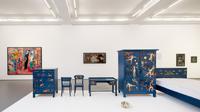
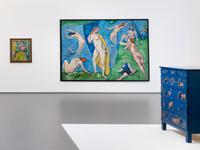

HLHE Sculpture Garden, Collection Kunstmuseen Krefeld and permanent loan of Freunde der Kunstmuseen Krefeld e.V.
© Andrea Zittel / Photo: Dirk Rose / Kunstmuseen Krefeld
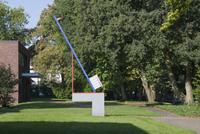

Collection Satelites
Since 2018, the art museums have been inviting artists from various disciplines to engage with the collection, museum history and architecture of the three buildings - Kaiser Wilhelm Museum, Haus Lange, Haus Esters - and to explore them in new ways with the Collection Satellite project series.
Research
The collection of the Kunstmuseen Krefeld is continuously studied and questioned based on ever-new perspectives by the museum’s staff as well as external scholars.
Conservation
The objective of conservation work is the care of the precious items in the collection and their preservation of behalf of future generations.